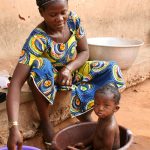Water for hygiene and sanitation
Apart from water to drink, it is needed for several domestic tasks: cooking and preserving food products, hygiene, personal and family cleanliness and sanitation. In 2015 there existed a great geographical and economic inequality for access to improved sanitation, which avoids human contact with their own excrement.
Globally, 68% of the world’s population has access to improved sanitation services, albeit with important differences between rural settlements, where it is available to half of households, and cities, where it reaches 82%. This implies that over a thousand million people concentrated in low income countries still have to defecate outside and live with the associated risks.
For the most part, these people live in subsistence agricultural settlements, but growing and chaotic migration from rural areas to urban centres –unplanned and with little or no infrastructure- means that nearly a third of urban residents in these countries have to live in overcrowded substandard housing, with no access to drinking water or sanitation.
The indicator which evaluates the availability of improved sanitation installations includes the percentage of the population who use any of the following sanitation installations without sharing with other households: pour-flush latrines, latrines with a cistern which discharges into a sewer via a pipe, septic tanks or pit latrines; improved pit latrines with ventilation; pit latrines with a covering slab; and composting toilets.




































